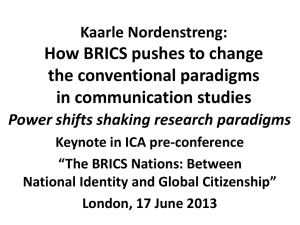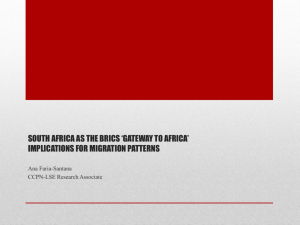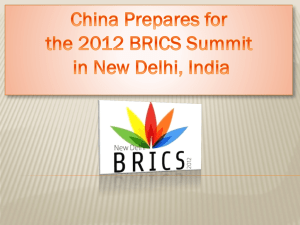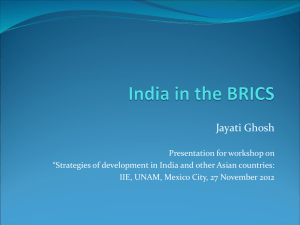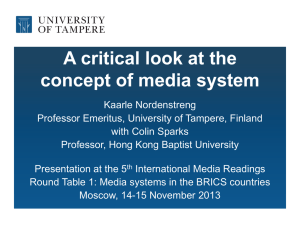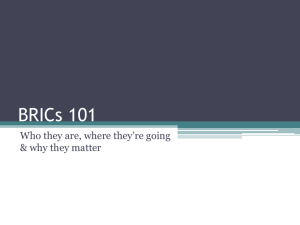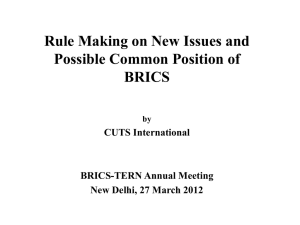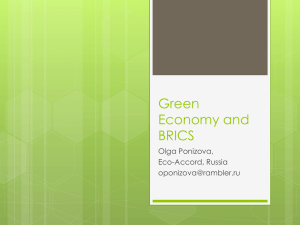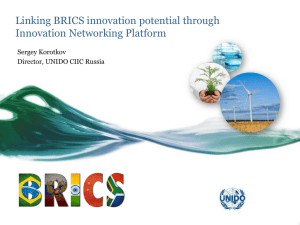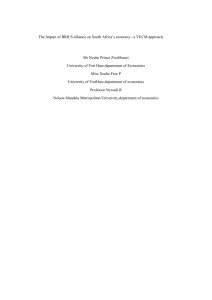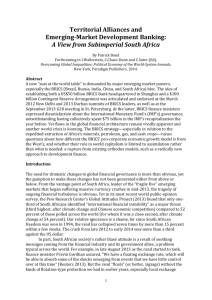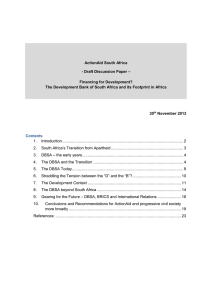South Africa - Reggio nel Mondo
advertisement
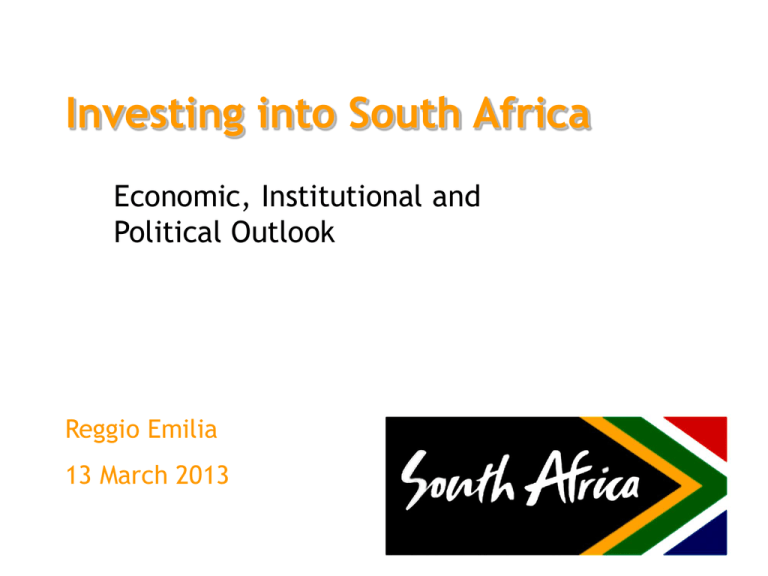
Investing into South Africa Economic, Institutional and Political Outlook Reggio Emilia 13 March 2013 South Africa at a glance •Area 1,220, 813 km2 •Population 50.59 million (2011) •Currency Rand (Euro 1 = Rand 11.58 Jan 2013) •Time GMT + 2 hrs •Head of the State: President Jacob Zuma •11 Official languages with English the business language •Total GDP: 305.8 billion € (2011) •GNI per capita: 5,214 € (2011) •Real GDP Growth: 3.5% (2011) •Inflation (CPI): 5.6 % (PPI): 5.5% (Oct 2012) •Main Exports: minerals & mineral products, precious metals & metal products, chemical & food products, automotives & components. • Main imports: machinery, transport equipment, finished products, oil, chemical products. •Main trading partners: Germany, USA, China, Japan, UK & France. South Africa- global perspective • South Africa is one of the most sophisticated and promising emerging markets, offering a unique combination of highly developed first world economic infrastructure with a vibrant emerging market economy • South Africa is one of the world’s 26 industrialised nations • The country is also regarded as the gateway to Africa • South Africa has the largest economy on the African continent, accounting for approximately 25% of the continent’s GDP • According to the World Bank, South Africa ranked 39th out of 183 in the world for the ease of doing business in 2012 • The Johannesburg Stock Exchange is Africa’s largest and most developed securities exchange and ranks 8th out of the G20 nations ahead of all the G7 countries South Africa - global perspective continued • South Africa remains the world’s top producer of minerals such as gold, platinum, rhodium, chrome, manganese and vanadium. • The country holds 80% of global manganese reserves, 72% of chrome, 88% of platinum-group metals (PGMs), 40% of gold and 27% of vanadium. • Unit labour costs in South Africa are significantly lower than those of many other emerging markets. • According to the 2012-2013 Global Competitiveness Index out of 144 countries, South Africa was ranked 52nd and scored well in various categories. SADC and South Africa • In August 2008 South Africa signed the Foreign Trade Agreement to be part of the Southern African Development Community (SADC) that represents a market of 200 million consumers. • In future, we expect that a further integration will take place between the three major regional blocks (SADC,COMESA & EAC), which is a potential future market of 700 million consumers. Investing in Africa: an improving environment The operating environment in the continent is improving visibly and rapidly … • • • The average economic growth rate in Sub-Saharan Africa is expected to be 6.6% in 2013 according to the African Development Bank. Many countries have improved their business environment: restored macro-economic stability greater predictability & increased reliability of policy & regulatory framework increased transparency and improved decision-making privatisation initiatives reduced corruption investment protection & promotion intra and inter-regional initiatives emerging middle class and growing consumerism fast-urbanising and youthful population High returns on investment. Ernst & Young estimates that FDI into Africa will reach $ 150 billion by 2015 driven by strong growth in new projects. BRICS and South Africa • In December 2010 South Africa was invited to join Brazil, Russia, India and China in the bloc of world’s leading emerging market economies, resulting in BRICS. • BRICS countries have individually emerged to assume new economic rankings and coordinate on their positions and actions in international organisations, as seen in the United Nations. • In the midst of the current global economic crisis, many countries in the world are looking at BRICS members as the new locomotives for global economic growth to provide renewed impetus to global economic cooperation. • BRICS trade and investment with low-income countries have served as a major support system in the wake of the global financial crisis (IMF Study). BRICS and South Africa •BRICS’ share of global output will increase from 18% to 26% over the next 10 years and even to one-third by 2030.The contribution to global economic growth over the last decade has reached 50%, which makes this group of states the leading power in global economic development. • GDP of BRICS member states in Billion USD in 2012: Brazil (2425.05); Russia (1953.56); India (1946.77); China (8250.24); South Africa (390.92). This constitutes 25% of the world GDP. • South Africa will host the 5th BRICS Summit on 26 and 27 March 2013 in Durban, which will complete the first cycle of BRICS summits. • On the occasion of the BRICS Summit, the BRICS Business Council will be launched. Each BRICS member will nominate 5 members that are leaders of the respective business organisations. The aim of the Council is to strengthen economic ties, trade and investment between the communities of the 5 BRICS countries. National Planning Commission • The National Planning Commission is a new initiative of government. The NPC is chaired by the Minister in The Presidency for National Planning and is responsible for developing a long term vision and strategic plan for South Africa. The Commission will also advise on cross-cutting issues that impact on South Africa’s long term development. • The establishment of the National Planning Commission is our promise to the people of South Africa that we are building a state that will grow the economy, reduce poverty and improve the quality of life of our citizens. • The Commission is made up of 25 part-time Commissioners appointed by the President on the basis of their skills and expertise. The Chairperson of the NPC is Minister Trevor Manuel and the Deputy Chairperson is Mr Cyril Ramaphosa. The Commission is supported by a fulltime secretariat of public servants. • On 15th August 2012 , the revised National Development Plan 2030 entitled, “ Our future-make it work” was handed to the President at a special joint sitting of Parliament. All political parties represented in Parliament expressed support for the NDP. • On 6th September 2012 the Cabinet Lekgotla welcomed the NDP as prepared by the National Planning Commission and acknowledged the plan as the strategic framework to form the basis of future government planning. • At the national conference of the ruling party ANC held at Manguang from the 16th to 20th December 2012, the Vision 2030 and the National Development Plan was embraced. South Africa and Italy – Bilateral Agreements Key bilateral agreements signed with Italy: • Bilateral Agreement on the Protection of Seamen in Distress (1890) • Cooperation on Industrial and Commercial Development (1892) • Avoidance of Double Taxation (1995) • Reciprocal Promotion and Protection of Investment (1996) • Memorandum of Understanding between Business Unity South Africa (BUSA) and Confindustria (2007) South Africa and Italy - Trade • Italy is an important trade partner for South Africa. Between January and September 2012 trade exchanges with Italy totaled 2.7 billion Euros with a positive balance in favour of South Africa. Italy is currently South Africa’s 14th client country and 11th supplier. • South Africa mainly exports primary commodities to Italy including minerals, precious stones, raw hides and skins and iron ores. • The leading imports basket from Italy into South Africa is made up of high value added manufactured products such as machinery, vehicles and other automobiles, electrical and electronic equipment, antibiotics and other pharmaceutical products. • The Government is striving to change the composition of exports from primary commodities and minerals into high value manufactured products through incentives and development programmes. South Africa and Italy - Investment • There is a stable presence of Italian companies that have invested in the country. Foreign Direct Investments from Italy totaled 111.93 million Rands in 2010, down from 321.49 million in 2009. • At the same time FDIs from other countries of the world dropped more heavily, thus making Italy the 10th biggest foreign direct investor in South Africa. • Some of the more prominent Italian investments into South Africa include: Salvatore Ferragamo (textiles), Ferrero (food), Telit (communications), SACE (financial services), Augusta (helicopters), Ansaldo (industrial systems), Fiat Auto (automotive), Luxottica (eyewear) and Building Energy (renewable energy). We trust this sound relationship between South Africa and Italy will continue to grow. Why invest in South Africa? Because you will find… Abundant natural resources Excellent transport & logistical infrastructure World class financial system Political & economic stability with sound macro-economic management Competitive sectors/industries Skills availability Favourable cost of doing business PROXIMITY TO MARKETS BY SEA • • • • • • • Liverpool – 25 days New York – 20 days Buenos Aires – 11 days Jeddah – 20 days India – 10 days Singapore – 12 days Hong Kong – 25 days South Africa – International Trade Agreements South Africa has signed a number of Foreign Trade Agreements in the world, which make it easier to do business. Among these are: •South Africa – European Union (EU) Trade, Development and Co-operation Agreement (TDCA) •Southern African Development Community (SADC) FTA •Southern African Customs Union (SACU) – India Preferential Trade Agreement (PTA) •Southern African Customs Union (SACU) - European Free Trade Association (EFTA) FTA •Africa Growth and Opportunity Act (AGOA) •SACU – Southern Common Market (Mercosur) Preferential Trade Agreement Industrial Development Zones South Africa has four Industrial Development Zones (IDZ), which are areas where production is facilitated. These are: • The Coega (near Port Elizabeth) – investment hotspot in the Eastern Cape for industries with global perspectives • East London -automotive industrial hub (Eastern Cape) • Richards Bay- terminal hub for coal exports (KwaZulu-Natal) and • Johannesburg International Airport (Gauteng)- situated in SA’s economic hub, OR Tambo Industrial Zone focusses on growth and competitiveness of the manufacturing sector in the province. Industrial Development Zones - continued The intention of IDZs is to provide investors in the zone with direct links to an international port and the facility to import inputs and goods into the zone customs duty-free and exempt from VAT. Each zone has dedicated customs support for faster processing of documentation. IDZs are suitable for export orientated production. The Government is currently working on a new policy for the development of new industrial nodes (called Special Economic Zones) outside of the traditional industrial areas while improving the performance of the IDZs. Investment Opportunities The Government offers attractive incentives to foreign investors. These are fully described in the DTI Guide to Incentives that will be made available to potential investors by our Economic Office in Milan. Some specific sector opportunities that I would like to highlight are: Sector Opportunities Infrastructure In his State of the Nation address President Jacob Zuma declared that infrastructure is a priority sector for the country’s economy. Over the coming 3 years R845 billion has been budgeted for public infrastructure projects. Five major geographically focused projects are: -Rail, road and water infrastructure integration project in Limpopo to unlock coal, platinum, palladium, chrome and other materials and to develop the beneficiation of minerals. -Improvement of logistics through the Durban-Free State-Gauteng industrial corridor with a range of rail and port improvements. -Construction of a new South Eastern node in the Eastern Cape to bolster the province’s industrial and agricultural development and export capacity. -Expansion of water, road, rail and electricity infrastructure in the North West. -A range of projects on the West Coast including the expansion of the SishenSaldanha iron-ore corridor. The private sector will play a role in the delivery of infrastructure through the state-owned companies (such as Transnet and Eskom) and the provincial departments of the nine provinces. Projects will appear on the Tender Bulletin and through the South African Development Bank on the following links: www.info.gov.za ; www.afdb.org Investment Opportunities - continued Manufacturing The manufacturing sector will receive R3.5 billion (342 million Euros) to establish incentives for local production and for SMEs that are in start-up phase or wishing to increase their capacity. Special emphasis is given to improving competitiveness in the industry and investment in technology. This includes production and upgrading of facilities in various sub sectors such as: textiles and clothing, renewable energy and energy saving industries, automotives & components. Agro-processing Over the coming 5 years R4.5 billion (440 million Euros) has been budgeted for agro-processing projects aimed at promoting the development of the rural economy. The main opportunities are in partnering with local farmers and SMEs to add value and export local products. These include: fisheries and aquaculture, floriculture, vegetable processing, fruit processing, meat processing, wine production, confectionary, indigenous teas, organic products, natural fibres and essential oils. Another interesting sub sector is production of biofuels, biodiesel & bioethanol. Research & Development South Africa will host over 75% of the Euro 1.5 billion Square Kilometre Array (SKA) with the rest located in Australia. This instrument is 50-100 times more sensitive and 10,000 times faster than any radio imaging telescope yet built. Cooperation with Italian companies in this sector will be an opportunity for both countries. Trade exhibitions Conferences and seminars, trade shows and expos are held across South Africa. These are important platforms for analyzing the market and meeting potential partners. You can find the calendar of events through the following link: http://www.southafrica.info/news/conferences/ Two major South African trade fairs: - Africa’s Big 7 (food & beverage) - Indutec (industry & technology) are represented in Italy through NGComBrokerSAS. For more information please contact: Mr. Giacomo Rotunno Tel. 051 7417932 E-mail: g.rotunno@ngcombroker.com Thank you! Contact details: South African Embassy Via Tanaro, 14 00198 Rome Tel. +39 06 852541 E-mail: sae2@sudafrica.it Economic Office South African Consulate-General Vicolo san Giovanni sul Muro, 4 2012 Milano Tel. +39 02 8858581 E-mail: dtimilan@thedti.gov.za
